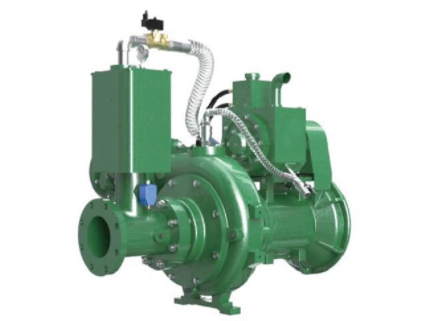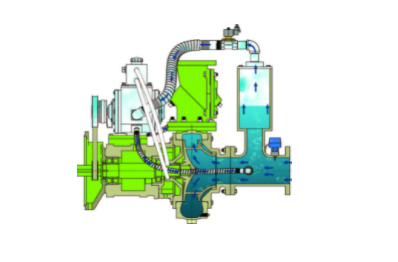Structural Features and Working Principle of Centrifugal Pump
 Nov 04, 2021|
Nov 04, 2021| View:390
View:390I. Structural Features of Centrifugal Pump
The structure of Centrifugal Pump is characterized by the following features: Inside the worm gear pump, an impeller is installed which can be rotated rapidly, and there are 2~8 blades on the impeller. There are two connections on the pump casing, the one leading to the center of the impeller is the inlet, which is connected with the suction line; the tangential direction of the pump casing is the outlet, which is connected with the discharge line.

The main working part of Centrifugal Pump is the impeller. Next is the suction chamber pump body (pump casing) pump cover, shaft sealing device (packing gland or mechanical seal), axial force balancing device, bearing, coupling, bracket, pressure chamber, design institute impeller workshop, the liquid can be inhaled from the suction port, constantly from the exhaust port, so that the height of the liquid pressure and exhaust.
Second, the working principle of Centrifugal Pump
Before starting, the liquid in the funnel is injected into the pump casing and suction pipe. When the impeller rotates rapidly, the liquid in the impeller rotates with the impeller blades, so that the liquid gets centrifugal force and moves outward from the center of the impeller along the blade channel, and then thrown out from the end of the blades into the worm chamber or the diffusion tube (or guide wheel) in the pump casing. When the liquid flows to the diffusion tube, due to the gradual expansion of the cross-sectional area of liquid flow, the flow rate slows down, part of the kinetic energy into static energy head, so that the pressure rises, so that the liquid is squeezed out of the discharge tube. At the same time, as the liquid is thrown out in the center of the impeller, a local vacuum is generated, so the liquid in the suction tank is continuously drawn into the pump from the suction pipe under the action of the liquid level pressure. The impeller rotates continuously to convey the liquid from the suction tank to the high level tank or pressure vessel.
Centrifugal Pump is a pump that uses a high speed rotating impeller to convey liquid by centrifugal force.
The bottom valve is a check valve to ensure that the liquid to be injected in the pump does not flow out of the suction pipe. A strainer prevents debris in the suction tank from entering the piping or pump casing and causing clogging. When the Centrifugal Pump is started, it cannot pump liquid if there is no liquid in the pump body and suction tube, because its suction port is connected to the discharge port. When there is no liquid inside the impeller but only air, because the density of air is much smaller than the density of liquid, no matter how the impeller rotates at high speed, the inlet of the impeller cannot reach the vacuum required for pumping, i.e. the centrifugal force generated is very small, therefore, the low pressure formed in the center area of the impeller is not enough to draw the liquid in the suction tank (storage tank) into the pump, but cannot draw the liquid into the pump. centrifugal pump The phenomenon of not being able to absorb liquid due to the air inside the pump is called air binding phenomenon. Therefore, before starting the Centrifugal Pump, liquid must be injected into the pump body and suction pipe or air must be pumped out.
Centrifugal Pump is not self-priming and must be filled before starting Centrifugal Pump. To prevent the liquid filled into the pump casing from flowing into the low level tank due to gravity, a check valve (bottom valve) is installed at the inlet of the pump suction line. If the position of the pump is lower than the level of the tank, there is no need to fill manually before starting, the liquid can automatically flow into the pump with the help of the level difference.

In the production process, although sometimes the pump is full of liquid, but there is still the phenomenon of not sucking liquid, which may be due to the following reasons
(1) The suction pipe connection flange is not tight and leaking.
(2)The filling is not enough, no exhaust, and there is still air in the pump casing or pipeline.
(3) The bottom valve of the inhalation pipe is not working or closed tightly, and the liquid is not enough.
(4) The valve or screen at the bottom of the inhalation tube is blocked.
(5) inhalation tube bottom valve is not open or failure, according to the specific situation to take appropriate measures to overcome.



